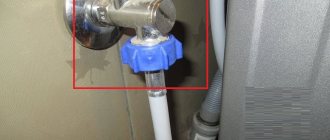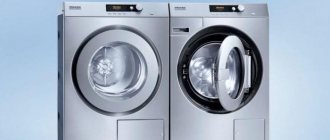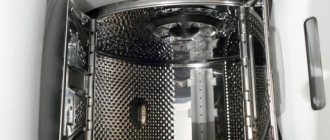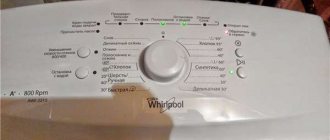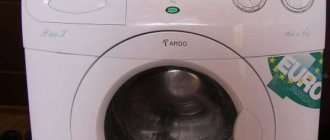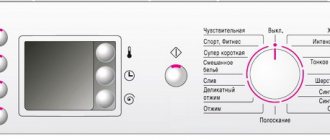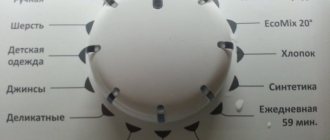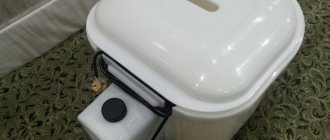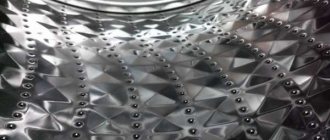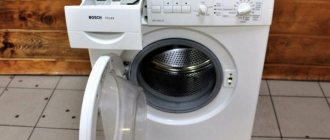Veko washing machines: new times - new functions
In addition to generally accepted standards, new technologies have prompted Beko to develop new functions:
- mode for eliminating lint and pet hair by adding wash cycles and rinsing,
- the necessary locking of the washing machine panels using special keys to avoid unexpected pressing, most often by children,
- aquafusion, which saves powder consumption by storing the latter in the drum of the Beko washing machine until the very end of the process,
- aquawave – electronic imbalance control for uniform placement of laundry in the tank,
- protection against power outages - automatic restart in case of power outages and resumption of washing at the interrupted place,
- a sensor to save from possible overflow, which reacts to exceeding the permissible water level in the Beko washing machine tank,
- half load mode – for a small amount of clothes. It is also important not to overdo the dosage of the detergent product,
- Silent tech™ technology – to reduce noise and spin during the washing process, reduce energy consumption and give a longer life cycle to the washing machine.
Thus, Veko washing machines are products that keep up with the times!
Convenience and improving reliability are the secret to the success of Veko washing machines
The use of the Veko technique is very comfortable, thanks to several significant improvements:
- LCD display displaying water temperature, spin speed, cycle stage, remaining time until the end of the process, other indicators,
- Volume hatch for loading, including large items - blankets and jackets,
- Expanded drum volume even with the miniature size of the Beko washing machine: with a depth of 35 cm - 5 kg. clothes, 40-45 cm - 6 and 7 kg., and with the standard - 8-9 kg.,
- Special tray for liquid laundry products, for use even with delayed start,
- High-tech heating elements with revolutionary nickel protection, which reduces scaling and protects against corrosion processes.
Veko washing machines are thought out with precision down to the smallest detail!
Veko washing machines: deciphering error codes
Not every Veko washing machine has an error display; some have one or another indicator on:
- H1 – faulty washing machine temperature sensor due to oxidation or damage to its contacts. To troubleshoot problems, test the thermistor wiring and measure the resistance. If information is displayed that differs greatly from the standard, the sensor must be replaced.
- H2 - display when a tubular electric heater malfunctions - the use of low-quality water with a considerable number of impurities that form scale on the heating element or drops in electrical voltage in the network.
- H3 – the heating element of the Beko washing machine remains in working condition and the set temperature is exceeded with the first and second indicator lights constantly burning. Problems with the temperature sensor or a control unit error cannot be ruled out.
- H4 – malfunction of the fill valve triac with the first and third indicators visible. It is necessary to monitor the condition of the wiring; diagnostics of the latter is recommended.
- H5 there is a problem with the drain pump, as evidenced by the second and third lights being on. The pump is cleaned if clogged, or replaced if there are significant defects.
- H6 – closure of the triac with notification by the first three indicators. Apparently there was a short circuit in a section of the triac, then it is replaced. The integrity of the wiring of the unit elements, the control module and the electric motor of the Beko washing machine are also monitored; if necessary, the components are repaired or replaced.
- H7 – problems with the controller related to the liquid level with the first three indicators lighting up. Possible reasons are electrical locking of the hatch doors, a malfunction of the pressure switch or module, or simply a closed valve.
- H11 – problems with the motor circuit of the Beko machine. In this case, it is important to evaluate the condition of the tachogenerator, bearings, brushes or wiring. If all the mentioned actions do not lead to results, then testing the triac is necessary.
The error codes described above will help you independently identify breakdowns and eliminate their causes.
Basic modes
Pictures take up less space, they are more impressive and are more suitable for the modern design of automatic washing machines (WMA). But their understanding is often difficult: not everyone will guess the first time what this or that picture means—instructions are used to decipher it. And most importantly, hand-drawn symbols are not standardized - each manufacturer is free to create them at his own discretion.
The Beko washing machine may not look so impressive because of the inscriptions, but they make operation as comfortable as possible. But the inscription is not a carrier of all the information - the names of the modes do not indicate either temperature or speed. Before you turn on programs, you should read their descriptions to know what they are suitable for.
| Program names | Description | Approximate process time, min |
| Cotton | Wash cotton linen in hot water. Range - 60–90 °C. You can even boil cotton fabrics without harming them. An option for heavily soiled cotton and other durable materials. Cotton fabric absorbs water strongly, so the laundry is wrung out at high drum rotation speeds | 120–150 |
| Ecocotton | For cotton items, subject to minimal energy costs | 180 |
| Dark fabrics | Good for synthetics and cotton items. Moderate temperature prevents shedding | 100 |
| Synthetics | For synthetic and combined materials. Moderate water heating prevents shedding and deformation | 105–120 |
| Shirts | These delicate items can be washed at 40°C. The program prevents bruising | 120 |
| Mix 40 | A universal mode in which you don’t have to separate the laundry - load it into the machine, regardless of the type of fabric. You can load synthetics and cotton items together into the drum. | User selection |
| Express | Quick wash mode. Speeds up programs for cotton and synthetics. Use for lightly soiled items. Condition - 50% drum load | 90–115 (depending on fabric) |
| Pooh | For blankets and down jackets, but can also be used for ordinary products | 60 |
| Sport | Wash clothes for sports. Removes stubborn stains | 100–140 (depending on fabric) |
| Mini | For small batches of not very dirty products | 30–90 (depending on temperature) |
| Handwash | For gentle care. Delicate fabrics that cannot be washed in a regular machine are washed. Eliminates deformation and wear | 40–55 |
| Wool | For woolen items. To prevent the wool from matting, use slow rotation of the drum | 60–70 |
| Kids' things | Washing with thorough rinsing - thanks to the large volume of water | 160 |
| Self-cleaning | Self-cleansing. The cycle starts with an empty drum | 120 |
| Jeans | For denim items. Prevents shedding | 100–105 |
| Refreshing wash | For easy freshening of slightly soiled clothes. Eliminates unpleasant odors | 17 |
| Economy mode | Cool water - 20 °C. Only for items that are not heavily soiled. It is recommended to use liquid detergent instead of powder. | 100 |
The duration of the programs given in the table is approximate, it is different for each model. You can find out the exact time in the instructions for a specific model.
Getting started right
It is very important to properly start the washing machine for the first time after purchase. Before installing the machine, be sure to remove the transportation bolts. The screws secure the tank, thus protecting it from damage when transporting the washing machine. Next, you should connect the equipment to communications and check the reliability of the connections.
After checking that the washing machine is ready for use, you can start washing. The hatch door opens and things are placed in the drum. Then the powder is poured into the tray; it is important not to exceed the dosage indicated on the packaging (usually 100 grams per wash cycle).
The dispenser has several compartments. One is for detergent, the other is for conditioner. This should definitely be taken into account when loading each of the compounds into the appropriate section. Next, you can plug the machine into the network, press the network button, turn the programmer to the desired mode and use the “Start” button.
Experts recommend running the machine “idle” for the first time, with an empty drum, but with powder, so that the equipment is “washed” from the inside.
If after starting the cycle the machine does not even think about starting work, you may not have closed the hatch tightly. It is necessary to check whether the door is “blocked”. The main task of the user during the first wash is to ensure that the machine operates in normal mode - does not make noise, does not hum, does not leak, and regularly draws and drains water.
Thus, for the first time you need to start the wash without loading clothes into the drum, but with detergent. The machine will be washed from factory dirt, and the unpleasant “chemical” aroma picked up from new washing machines will disappear. Afterwards, the machine will be ready to accept a batch of items for cleaning.
Is it worth buying Beko washing machines: reviews
Owner opinions always play an important role in the choice of equipment. They can carry a lot of useful information. For example, how well the device works, what nuances may arise during operation, how useful the available functions and additional options are.
Reviews of the WKB 61031 PTMS model
Arthur, Syzran
Very good washer. Has many useful options. And the price is very affordable. Among the shortcomings, I can note a lot of noise during the spin cycle.
Tatyana, Svetogorsk
In operation for 5 years. I'm happy with the purchase. Beautiful design, useful programs, convenient controls. It's small in size, so it fits in our bathroom without any problems.
During the installation process, a problem arose - the drain hose turned out to be short (only 1.5 meters) and without a tip. So I had to go shopping for an extension cord. Otherwise, everything is quite satisfactory.
Reviews of "Beko" WKB 51031 PTMS
Alisa, St. Petersburg
Purchased in 2013. Over a couple of years of operation, the belt was changed, then the motor brushes, and a year later the hatch locking device broke. Repairs were generally not expensive. In defense of the device, I can say that we use it intensively, running several cycles a day. It washes well, but the main thing is not to overload. If the laundry in the drum is bunched up, it doesn’t wring out well.
Igor, Alchevsk
Satisfied with the quality, it washes great. My wife is especially happy with the animal hair removal feature. Indeed, it does not leave any lint on clothes. Among the shortcomings I will say that it is noisy in operation. But we solved this problem with the help of anti-vibration stands. Another minus is that the drum is small, 5 kg definitely won’t fit there, maximum 3.5.
Production of Beko automatic machines: who produces them and where?
The Beko brand is part of the Arçelik A.Ş. company, which is part of the Turkish corporation Koç Holding. The company released its first automatic machine in 1959.
It is noteworthy that the Beko brand was originally created to promote goods abroad.
Export of products to European countries under the brand began in 1990. Today, products are sold in more than 100 countries.
Having found out whose company the brand is, let’s move on to the issue of production of Beko machines. Where are they produced, besides Turkey - the country of origin of the brand? It turns out that the production of washing machines has also been established in Russia. In 2006, a plant was built in the city of Kirzhach to assemble all types of cars and refrigerators. The annual output of the plant is more than 700,000 units.
Information about the country of origin is indicated on the device plate (factory sticker).
In addition to the assembly location, on the factory sticker you can find information such as name, brand, product type, serial number.

